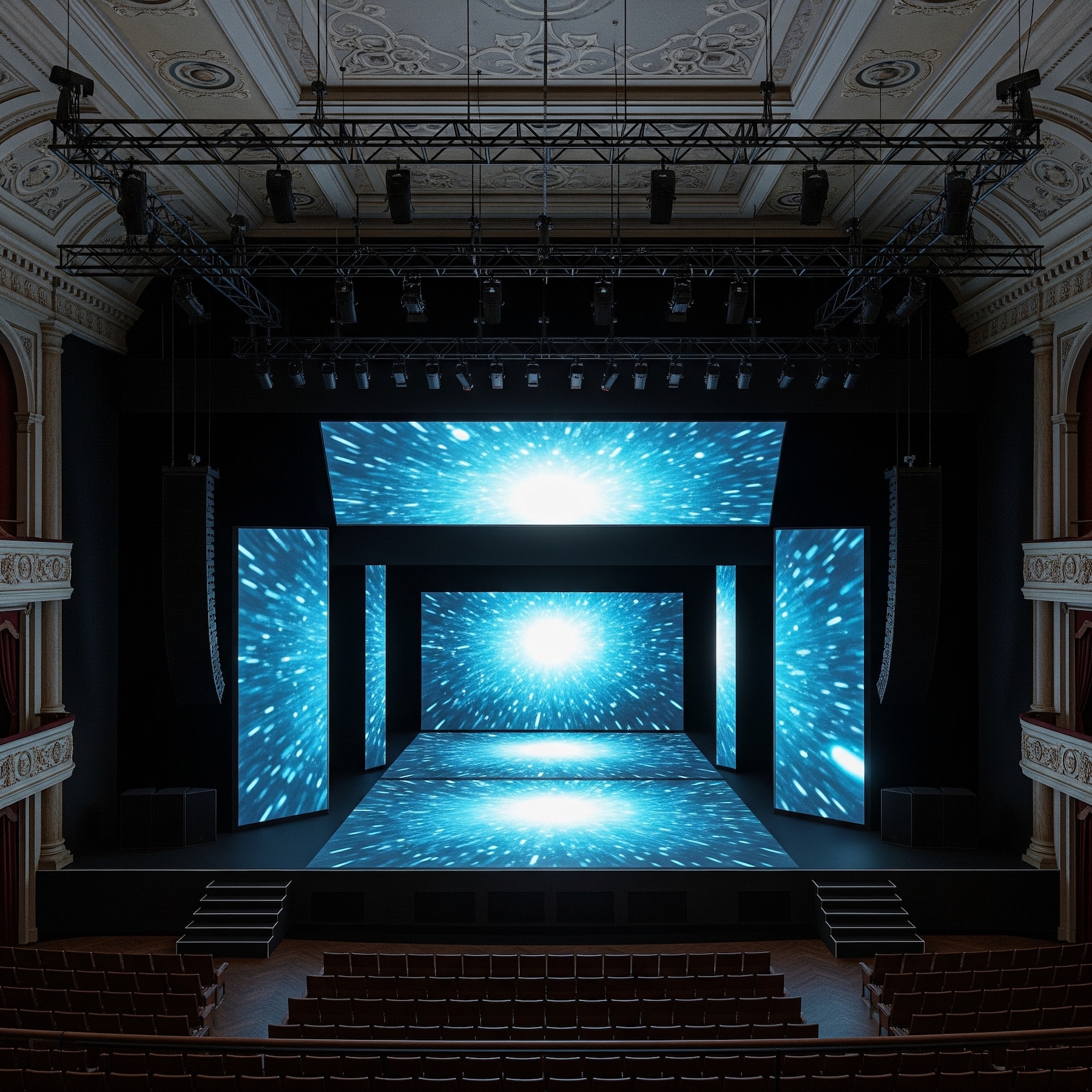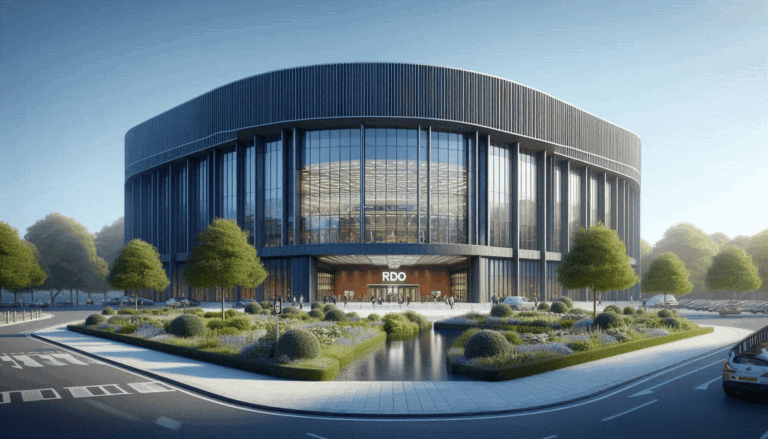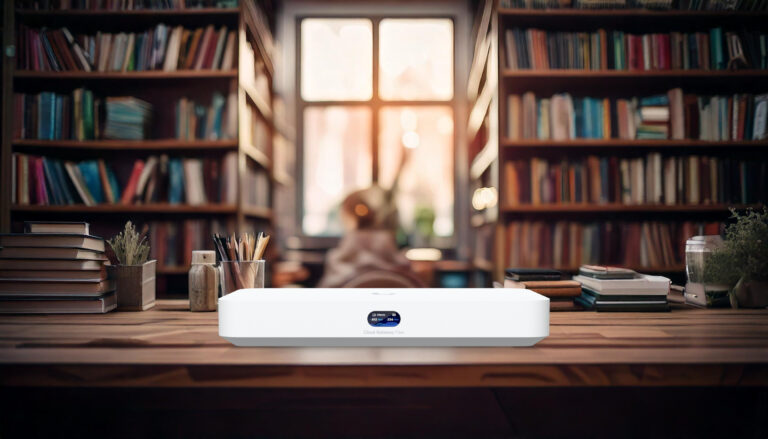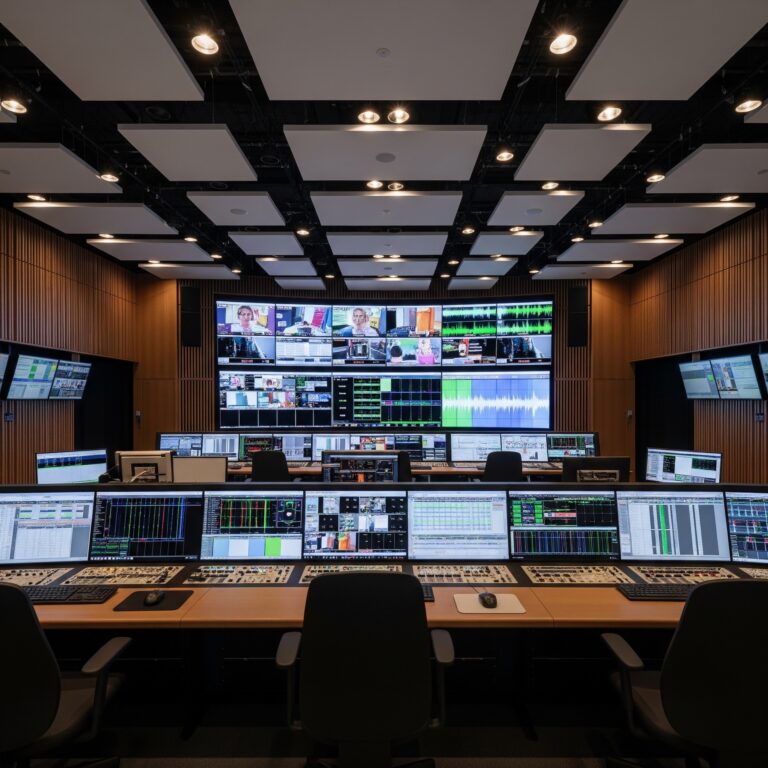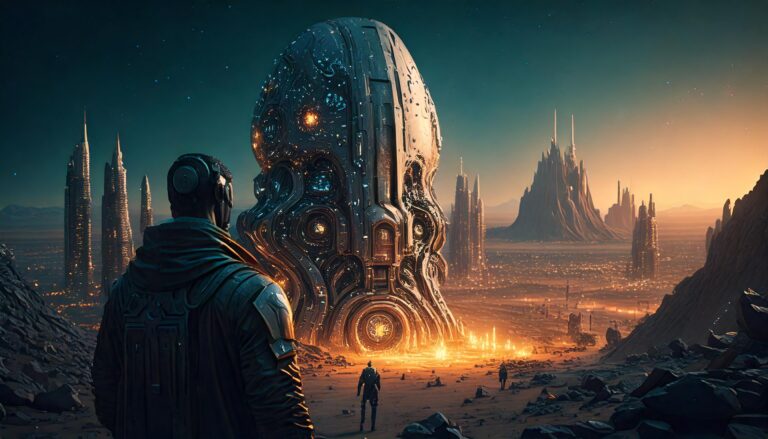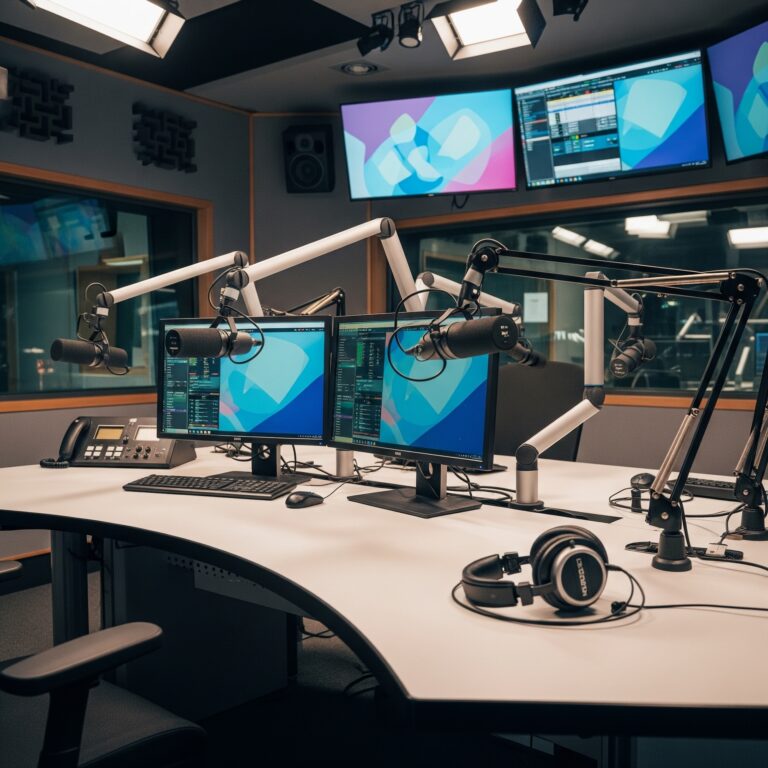Reimagining the Stage: Designing a Cutting-Edge Theatre for the Carnaby Media Hub
Introduction: A Theatre for the Future
Remember our grand vision for the Carnaby Media Hub? That ambitious theoretical production powerhouse designed to bring together diverse creative disciplines under one roof? Well, today, we’re zooming in on one of its most exciting components: a state-of-the-art theatre space. But this isn’t just any theatre; it’s a meticulously designed arena that blends the timeless charm of traditional performance venues with the cutting-edge technology of the 21st century.
My inspiration for this particular space comes from a venue I know intimately – The Spa Theatre in Bridlington. While it holds a special place in my heart for its classic design and the countless shows I’ve experienced (and perhaps occasionally gotten excited during!), the Carnaby Media Hub’s theatre takes that foundation and propels it into a future of unparalleled adaptability. We’re talking about a stage where the very structure can transform, where light, sound, and visuals are delivered with digital precision, and where intimate performances can effortlessly pivot to large-scale, immersive experiences. Join me as we pull back the curtain on a theatre truly built for tomorrow’s storytellers.
A Familiar Foundation: Drawing Inspiration from The Spa Theatre
The vision for the Carnaby Media Hub’s theatre space is deeply rooted in a fondness for classic theatre design, and in that regard, The Spa Theatre in Bridlington serves as a significant touchstone. For those familiar with this charming venue on the East Yorkshire coast, you’ll recognize certain key elements that we aim to carry forward into our modern interpretation.
One of the most appealing aspects of The Spa Theatre is its traditional proscenium arch stage. This classic configuration provides a clear separation between the performance space and the audience, creating a defined picture frame for the action on stage. This sense of focus and theatrical tradition is something we want to retain in the Carnaby Media Hub’s theatre.
Furthermore, the overall dimensions of The Spa Theatre’s stage offer a practical framework for our design. With a stage depth of approximately 11.89 meters (this is from the very front of the stage to the back wall and not to the Cyc), a proscenium width of 9.14 meters, and a total stage width spanning 17.07 meters, it provides a substantial area for performances and backstage operations. The generous height to the grid at 15 meters is also a crucial element, offering ample vertical space for rigging and scenery.
The presence of an orchestra pit is another feature I appreciate. It was seemingly only a small step down from the stalls (a fact I really should have measured properly at some point!), as I recall from my time there focusing those uplighters – at 6’1″, my head only just peeked above the stage floor! This sunken area allows musicians to accompany performances without obstructing sightlines, creating a seamless blend of music and drama. The experience of being in that pit at The Spa, even just for technical setup, offered a unique perspective and connection to the performance.
Finally, the layout of the stalls in The Spa Theatre, sloping gently towards the stage and widening towards the rear (approximately 18 meters at its widest point before tapering towards the stage), provided good sight-lines for the audience. Even the slightly less-than-soundproofed tech booth at the back, with its occasional bursts of enthusiastic (and perhaps slightly loud) direction, added a certain charm and a reminder of the live, dynamic nature of theatre! And of course, who could forget the grand chandelier hanging above the stalls, a beautiful albeit slightly perilous piece of Edwardian engineering! It was a 650-seat theatre with 280 seats in the stalls and the remainder in the circle.
Departing from Tradition: Tailoring the Design for Carnaby
While I’ve draw significant inspiration from The Spa Theatre’s fundamental layout and dimensions, the Carnaby Media Hub’s theatre will also embrace some key departures, tailored to its unique purpose, modern technological advancements, and, I’ll happily admit, a healthy dose of Eurovision influence!
One of the most notable changes will be the omission of the traditional circle seating. The Carnaby Media Hub’s theatre is envisioned as a more intimate space, often serving as a permanent set piece or a highly adaptable environment for smaller, more focused productions. By removing the circle, we can optimize sightlines and create a more direct connection between the performers and the entire audience within the stalls. This design choice will also influence the overall architecture of the auditorium, allowing for a potentially more streamlined and focused aesthetic.
However, in place of a larger seating capacity afforded by a circle, the Carnaby Media Hub’s theatre will incorporate a thrust stage. Extending outwards from the proscenium arch into the audience area, a thrust stage offers several advantages. It brings the performers closer to the audience, enhancing intimacy and creating a more immersive experience. It also provides more varied sightlines, making the performance dynamic from different perspectives. Furthermore, a thrust stage retains the benefits of a backstage area accessible via the proscenium, allowing for seamless scene changes and technical operations hidden from the audience’s view. This is a key difference from The Spa Theatre’s original configuration but a deliberate choice to enhance the versatility of the CMH’s theatre.
Beyond the seating and stage configuration, we’ll be introducing some significant visual and technical changes:
- Permanent Video Wall: Replacing the traditional cyclorama at the rear of the stage will be a large, high-resolution video wall. This will provide a dynamic backdrop for performances, allowing for stunning visual effects, virtual scenery, and creative storytelling possibilities. (And yes, it’s totally inspired by the wow factor of Eurovision!) We’ll ensure there’s still adequate space behind the wall for crew movement.
- Integrated Stage and Set Elements: Taking further inspiration from modern stage productions, we’ll incorporate video-capable stage coverings (the “floor”) and “legs and borders” (the masking that hides the sides and top of the stage). This integration of video elements allows for a cohesive visual environment and offers practical benefits. As anyone who’s ever spent hours painstakingly marking out a stage with glow tape knows, having a video floor that can display those cues is a game-changer for set changes in the dark!
- Automated Rigging and Fly Floor Removal: To maximize efficiency and flexibility, the theatre will feature a fully automated rigging system. This advanced system will allow for precise and rapid changes to scenery and lighting configurations. As a consequence, we’ll be removing the traditional fly floor, streamlining the backstage space and improving safety.
- Reimagined Orchestra Pit/Sound Studio: We’re rethinking the orchestra pit entirely. Instead of a simple sunken area, we envision a fully built-out, soundproofed recording studio beneath the stage. This studio could serve as a dedicated space for recording music and sound effects, and it could also be opened up to the auditorium via soundproof doors to accommodate a live orchestra when needed. This approach offers dual functionality and maximizes the use of the theatre’s space.
- Dimmers Be Gone! (Mostly): In a move towards a fully digital lighting workflow, we’ll be removing traditional dimmers. All lighting fixtures will be LED-based and controlled via Art-Net (or DMX if they do not have an ethernet port). This provides finer control over color and intensity, reduces energy consumption, and simplifies cabling. However, we will retain three-phase hardline power around the venue to accommodate touring companies or productions that might bring in their own dimmer-based rigs or other high-power equipment.
- Ubiquitous Networking: Cat6 and Fiber Throughout: This is where the “digification” really takes hold! Unlike older venues that might have an Ethernet port here and there, the CMH theatre will be a densely networked environment. We’re talking widespread Cat6 cabling for all our IP-based systems (lighting control, audio over IP, basic data), complemented by extensive fiber optic runs for high-bandwidth video (2110 IP, anyone?) and long-distance connectivity. This ensures that every piece of modern, IP-enabled kit has the robust network connection it needs, right where it’s needed.
- Modernized Internally Wired Bars (IWBs): Forget those old 15A sockets! Our internally wired bars will be a huge step up. Each bar will feature multiple 16A CeeForm sockets for robust power delivery to modern lighting fixtures and other equipment. Crucially, each bar will also offer approximately six “channels” of permanent, hardlined power. To ensure flexibility and easy removal of these bars when required, this power will be delivered from the main circuit board/relays via industry-standard Socapex cables. This setup means quick changes, reliable power, and no more fumbling with adapters or running extra cables for every single fixture.
- A Transformable Auditorium Ceiling and Seating: To truly unlock the theatre’s potential for diverse events beyond traditional proscenium shows – imagine anything from immersive experiences to flat-floor exhibitions or even intimate concerts with the stage extending into the room – we’re designing the auditorium with extreme adaptability in mind. The ceiling will incorporate elements that can move on a hoist, much like the impressive setup at the Royal Albert Hall. Crucially, certain sections of these ceiling elements will also be removable, allowing for easy rigging of trusses or other items front of house, ensuring maximum flexibility for overhead setups. Complementing this, the seating in the stalls will be fully collapsible, designed to roll away and disappear into recessed areas or walls at the rear of the auditorium. This instantly transforms the sloped seating area into a vast, flat floor, providing unparalleled flexibility for different layouts and uses.
The Backbone of Performance: Advanced Technical Systems
Now that we’ve established the physical layout and key architectural departures for the Carnaby Media Hub theatre, let’s dive into the exciting part: the cutting-edge technical systems that will truly make this a theatre for the future. This is where the magic happens, and believe me, we’re sparing no expense (in theory!) to ensure peak performance and limitless creative possibilities.
Automated Multi-Point Rigging System
Gone are the days of manual counterweight flying for everything. For the CMH theatre, we’re envisioning a sophisticated automated multi-point rigging system. This isn’t just about hanging lights and scenery; this system will be powerful enough to precisely control and fly performers themselves! Imagine the breathtaking moments we could create with performers soaring seamlessly through the air.
This type of system offers unparalleled precision, repeatability, and safety, allowing for complex choreography of both scenic elements and human flight. It means rapid scene changes, dynamic set transformations, and the ability to execute cues with absolute accuracy, show after show. By embracing this technology, we unlock a whole new dimension of theatrical storytelling, far beyond what traditional rigging allows. The integration of this system is also what allows us to confidently remove the old fly floor, as all control will be centralized and automated.
LED Lighting Revolution
As mentioned, we’re taking a bold step: out with traditional dimmers (mostly!), and in with an all-LED lighting rig controlled entirely over Art-Net (or DMX for any legacy fixtures that sneak in). Art-Net, an Ethernet-based protocol, allows for far more data to be transmitted at much higher speeds than traditional DMX, meaning smoother fades, more precise control, and the ability to manage thousands of parameters simultaneously. This translates to incredibly nuanced lighting designs and complex visual effects.
To bring this vision to life, we’d be looking to robust and versatile fixtures from a leading brand like Robe Lighting. Their range offers the quality and innovation we’d need across various applications:
- Robe Tarrantula: A powerful LED wash beam fixture, perfect for broad washes of colour and dynamic aerial effects.
- Robe Spikie: A super-fast, small LED wash beam, great for tight beams, punchy effects, and rapid movements.
- Robe WTF!: A unique LED beam effect fixture, ideal for creating distinctive looks and adding visual flair.
- Robe Tetra2: An incredibly versatile LED bar fixture, excellent for cyclorama washes, pixel-mapping effects, and defining architectural lines.
- Robe Footsie2: A compact, low-profile LED footlight, perfect for front-of-stage lighting, providing a clean wash without spilling into the audience.
- Robe LEDWash 600X: A workhorse LED wash fixture, known for its bright output and excellent colour mixing, perfect for general stage illumination.
- Robe iParFect 150 FWQ RGBW: A robust, IP65-rated LED PAR fixture, suitable for both indoor and potentially outdoor (or spill-prone) applications, offering vibrant colour washes.
- Robe iForte LTX FS, iForte Fresnel, iForte LTX WB: These are parts of Robe’s cutting-edge iSeries, which includes sealed fixtures suitable for challenging environments. The LTX FS (FollowSpot), Fresnel, and LTX WB (Wash Beam) offer powerful, consistent output and precise control, ensuring excellent key lighting and dynamic effects.
- Robe T32 Cyc: Dedicated LED cyclorama fixtures, designed to deliver smooth, even washes of colour across the permanent video wall, enhancing its visual impact.
This curated selection ensures we have the right tools for every lighting task, from subtle washes to dramatic aerial beams, all managed seamlessly over our dedicated Art-Net network.
Dante Audio Network
For audio, the industry standard for high-quality, low-latency audio over IP is Dante, and that’s exactly what we’ll be building our theatre’s sound infrastructure around. Dante replaces bulky, analogue multi-core cables with standard Ethernet, allowing hundreds of channels of audio to be routed digitally with incredible flexibility and pristine quality.
Our main audio backbone will be anchored by elements from the Yamaha Rivage PM Range, known for its exceptional sound quality and comprehensive control:
- Yamaha CSD-R7 (Rivage PM7) Mixing Console: This console would serve as the central command for all audio, offering a vast channel count, powerful processing, and an intuitive interface for our sound engineers. Its native Dante integration makes it the perfect hub for our digital audio network.
- Yamaha RPio622 Stageboxes: We’d pair the console with a couple of these stageboxes. These remote I/O (input/output) units are strategically placed around the stage and auditorium, converting analogue microphone and line signals to Dante and vice-versa, and feeding them directly into our network. This dramatically reduces cable runs and ensures signal integrity.
Powering our “normal” line array speaker system (no specific model chosen yet, but think high-end theatre-grade!) would be D&B audiotechnik D80 amplifiers. D&B are renowned for their audio quality and reliability, and the D80s offer Dante integration, allowing for direct digital audio feed from our network to the amplifiers, maintaining signal purity right up to the speakers.
To ensure our audio chain is as digital as possible from source to destination, we’d prioritize Dante-enabled inputs. This includes the Shure ULX-D Wireless Microphone System, which offers excellent sound quality and robust RF performance, with direct Dante outputs to integrate seamlessly into our network. For playback, a Tascam SS-CDR250N would handle physical media playback (CD/USB), also with Dante connectivity. Crucially, a dedicated computer within the venue would also be configured to output multi-channel audio directly over Dante, perfect for QLab or other playback software.
2110 IP Video Infrastructure
Just as Dante has revolutionized audio, ST 2110 IP is doing the same for professional video. This standard, formally known as SMPTE ST 2110, allows for the transport of uncompressed, unencapsulated video, audio, and ancillary data flows over standard IP networks. This is critical for the high-resolution, low-latency video demands of our permanent video wall and integrated stage visuals. It means incredible flexibility, scalability, and pristine video quality without the limitations of traditional SDI cabling.
For our 2110 IP video infrastructure, we’d be looking entirely to Blackmagic Design products. They offer a comprehensive ecosystem of affordable yet powerful 2110-enabled devices:
- Blackmagic 2110 IP Converters: These would be fundamental, converting traditional SDI signals from various sources (like cameras or playback devices) into ST 2110 IP streams, and vice-versa, allowing us to integrate a wide array of equipment into the IP network.
- Blackmagic SmartView 4K G3: This 2110 IP-enabled monitor is perfect for high-quality video monitoring anywhere on the network, allowing technicians to verify video signals with precision.
- Blackmagic Audio Monitor 12G G3: Another 2110 IP-enabled device, this would allow for critical audio monitoring within the IP video streams, ensuring that both picture and sound are perfectly synchronized.
- Blackmagic URSA Broadcast & Blackmagic Studio Camera Pro: These professional cameras, already capable of high-quality output, would be integrated into the 2110 IP workflow using converters or potentially direct IP connectivity (as Blackmagic continues to innovate), providing pristine camera feeds for projection, recording, or live streaming.
By adopting 2110 IP with Blackmagic Design, we’re building a future-proof video infrastructure that offers incredible flexibility, high performance, and seamless integration with our other networked systems.
The Theatre’s Potential
With its blend of traditional proscenium elements, a dynamic thrust stage, cutting-edge technical systems, and an astonishingly adaptable auditorium, the Carnaby Media Hub’s theatre isn’t just a venue; it’s a playground for creators and a portal to unparalleled experiences for audiences. This space is designed to empower artists and technicians to push boundaries and redefine what’s possible in live performance and immersive media.
So, what types of productions would truly thrive here?
- Intimate & Immersive Theatre: The absence of a circle and the presence of the thrust stage immediately foster a more intimate connection with the performers. This is perfect for contemporary dramas, experimental pieces, or even unique interpretations of classics where audience proximity enhances the emotional impact. Imagine a single actor holding an entire audience in the palm of their hand, with subtle lighting cues and sound design making you feel like you’re part of the narrative.
- Hybrid Live & Digital Performances: This is where the permanent video wall, video floor, and 2110 IP video infrastructure really shine. Productions can seamlessly blend live action with stunning digital backdrops, interactive projections, and virtual environments. Think of a concert where the stage itself becomes a dynamic canvas for visual art, or a play where the setting shifts instantly from a bustling city street to a tranquil forest with a mere flick of a digital switch. The possibilities for augmented reality in live performance are truly exciting here.
- Technically Ambitious Musicals & Dance: With the automated multi-point rigging system, flying performers and complex scenic changes become not just feasible, but elegant. Choreographers and directors can unleash their imaginations, designing breathtaking aerial sequences or rapid transformations that would be impossible in traditional venues. The precise Art-Net lighting and Dante audio mean every cue, every note, and every vocal nuance is delivered with pristine clarity and impactful design.
- Concerts & Live Music Events: Beyond theatrical productions, the transformable auditorium ceiling and collapsible seating make this an incredibly versatile concert venue. Flatten the floor, bring in standing audiences, and configure the stage for a band, all while leveraging the advanced audio system and dynamic video elements for an unforgettable live music experience. The ability to remove ceiling elements also allows for optimal rigging of concert trusses, ensuring world-class production values.
- Corporate Events & Product Launches: With its state-of-the-art AV capabilities, flexible layout, and high-tech aesthetic, the theatre also becomes a premium space for corporate events, product launches, and conferences. Companies can utilize the video wall for powerful presentations, the thrust stage for engaging speakers, and the dynamic lighting and audio to create a truly memorable brand experience. The flat-floor option could easily accommodate exhibition booths or interactive displays.
The overarching goal is to create an immersive experience for the audience, regardless of the art form. Every design choice, from the intimate seating to the integrated video and precise automation, funnels into drawing the audience deeper into the performance. This isn’t just a place to watch a show; it’s a place to experience it in a truly profound and flexible way.
A Stage Set for Innovation
So, we’ve taken quite the journey through the theoretical design of the Carnaby Media Hub’s theatre. What began with the familiar echoes of The Spa Theatre’s classic proscenium arch and stage dimensions has evolved into a powerhouse of modern performance. By embracing a flexible thrust stage, installing a permanent video wall and integrated video floor, and adopting an automated multi-point rigging system that even allows for performer flight, we’re building a space where creative limits are pushed daily.
The commitment to an all-LED lighting rig controlled by Art-Net, a comprehensive Dante audio network, and a full 2110 IP video infrastructure ensures digital precision, unparalleled quality, and incredible versatility. Coupled with ubiquitous Cat6 and fiber networking, modernized internally wired bars, a reimagined soundproofed orchestra pit/recording studio, and a truly transformable auditorium with a hoist-capable ceiling and collapsible seating, this theatre is more than just a venue – it’s a dynamic canvas. It’s a testament to how traditional theatricality can be amplified by cutting-edge technology to create truly immersive and unforgettable experiences, whether for intimate drama, grand concerts, or corporate showcases. This theatre isn’t just a part of the Carnaby Media Hub; it’s a shining example of its core philosophy: innovation driving creativity.
What’s Your Take on my Dream Stage?
What do you think of this deep dive into the Carnaby Media Hub’s theatre design? Are there any features that particularly excite you, or perhaps aspects you’d approach differently? We’re laying the groundwork for a truly future-proof venue, and your insights are invaluable! Head over to the social media post that led you here and drop your comments – let’s discuss how this dream stage could truly come to life!


